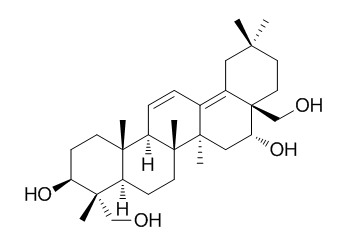Saikogenin D
Saikogenin D possesses a dual effect: an inhibition of A23187-induced PGE2 production without a direct inhibition of cyclooxygenase activity; and an elevation of [Ca2+]i that is attributed to Ca2+ release from intracellular stores. Saikogenin D has immunomodulatory effect, it can attenuate IL-6 production in LPS-stimulated alveolar macrophages of B6 more than in that of BALB.
Inquire / Order:
manager@chemfaces.com
Technical Inquiries:
service@chemfaces.com
Tel:
+86-27-84237783
Fax:
+86-27-84254680
Address:
1 Building, No. 83, CheCheng Rd., Wuhan Economic and Technological Development Zone, Wuhan, Hubei 430056, PRC
Providing storage is as stated on the product vial and the vial is kept tightly sealed, the product can be stored for up to
24 months(2-8C).
Wherever possible, you should prepare and use solutions on the same day. However, if you need to make up stock solutions in advance, we recommend that you store the solution as aliquots in tightly sealed vials at -20C. Generally, these will be useable for up to two weeks. Before use, and prior to opening the vial we recommend that you allow your product to equilibrate to room temperature for at least 1 hour.
Need more advice on solubility, usage and handling? Please email to: service@chemfaces.com
The packaging of the product may have turned upside down during transportation, resulting in the natural compounds adhering to the neck or cap of the vial. take the vial out of its packaging and gently shake to let the compounds fall to the bottom of the vial. for liquid products, centrifuge at 200-500 RPM to gather the liquid at the bottom of the vial. try to avoid loss or contamination during handling.
Nanjing University of Chinese Medicine2022, 345930.
Regen Biomater.2023, 10:rbad077.
Appl. Sci.2020, 10,1304
Life Sci.2022, 311(Pt A):121157.
Food Science and Biotechnology2022, 10.1007.
Int J Mol Sci.2019, 20(23):E6071
Chin J Appl. Physiol.2019, 35(3):283-288
Environ Toxicol.2021, doi: 10.1002
Molecules2022, 27(14):4601
J. of The Korean Society of Food Culture2017, 144-149
Related and Featured Products
Planta Medica, 2003, 69(8):765.
Dual effect of saikogenin D: in vitro inhibition of prostaglandin E2 production and elevation of intracellular free Ca2+ concentration in C6 rat glioma cells.[Pubmed:
14531029]
To clarify the pharmacological profile of Saikogenin D, we examined the effect of Saikogenin D on prostaglandin E2 (PGE2) production and intracellular free Ca2+ concentration ([Ca2+]i) in C6 rat glioma cells.
METHODS AND RESULTS:
Saikogenin D (1-20 microM) inhibited PGE2 production induced by the Ca2+ ionophore A23187 in a concentration-dependent manner with the IC50 of about 3 microM. Saikogenin D did not affect the conversion of arachidonic acid into PGE2 in microsomal preparations. On the other hand, Saikogenin D elevated [Ca2+]i in a concentration-dependent manner (10-100 microM) with the EC50 value of about 35 microM in the presence or absence of extracellular Ca2+.
CONCLUSIONS:
These results suggest that Saikogenin D possesses a dual effect: an inhibition of A23187-induced PGE2 production without a direct inhibition of cyclooxygenase activity; and an elevation of [Ca2+]i that is attributed to Ca2+ release from intracellular stores.
International Immunopharmacology, 2002, 2(2–3):357-366.
The herbal medicine Shosaiko-to exerts different modulating effects on lung local immune responses among mouse strains[Pubmed:
11811938]
Shosaiko-to (SST), a Chinese/Japanese traditional herbal medicine, has recently been demonstrated to increase lung interleukin-6 (IL-6) levels and to ameliorate pulmonary disorders in BALB/c mice (BALB).
METHODS AND RESULTS:
In the present study, we examined the effects of SST on lung cytokine levels and lipopolysaccharide (LPS)-induced lung injury in C57BL/6 mice (B6), which are known to show different immune responses from BALB due to the difference in genetic backgrounds. In B6, in contrast with BALB, SST decreased lung IL-6 levels and exacerbated LPS-induced lung injury. Investigation of the active components of SST suggested that multiple ingredients were supposed to be responsible for IL-6-attenuating activity in vivo. Further, we examined the effect of metabolites of major ingredients of SST on IL-6 production from lung immune cells in vitro. Saikogenin D and oroxylin A attenuated IL-6 production in LPS-stimulated alveolar macrophages of B6 more than in that of BALB. Liquiritigenin, which was previously reported to enhance IL-6 production in anti-CD3 monoclonal antibody-stimulated lung mononuclear cells of BALB, showed no effect on that of B6.
CONCLUSIONS:
These findings suggest that SST may have different, possibly even opposite, effects on lung immunity in hosts with different genetic backgrounds.



